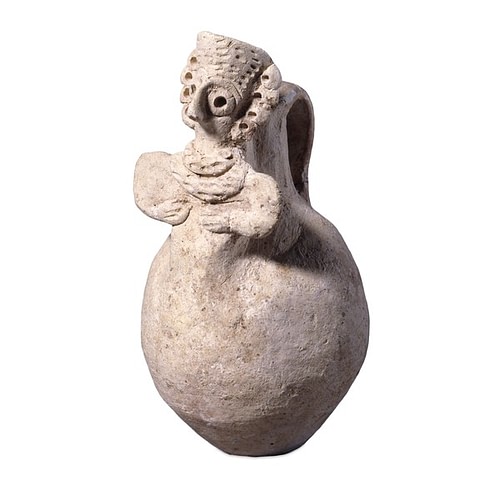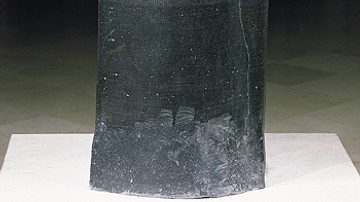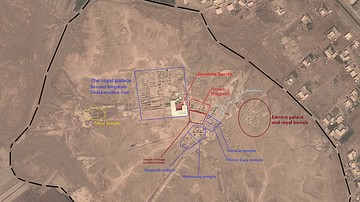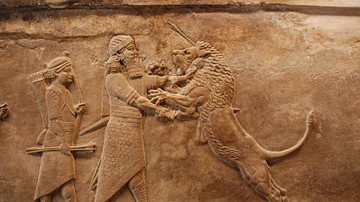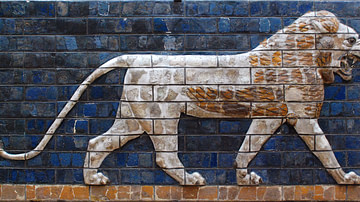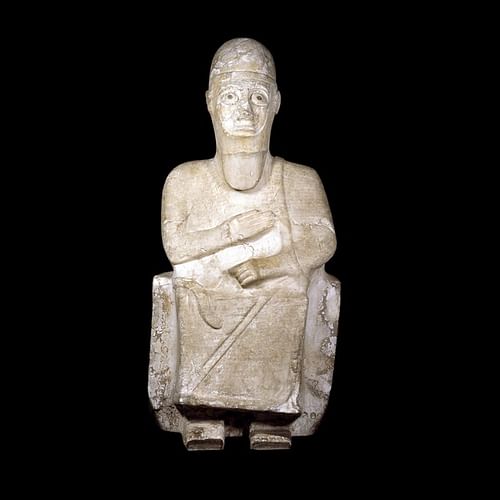
The Amorites were a Semitic people who seem to have emerged from western Mesopotamia (modern-day Syria) at some point prior to the 3rd millennium BCE. In Sumerian they were known as the Martu or the Tidnum (in the Ur III Period), in Akkadian by the name of Amurru, and in Egypt as Amar, all of which mean 'westerners' or 'those of the west', as does the Hebrew name Amorite. They worshipped their own pantheon of gods with a chief deity named Amurru (also known as Belu Sadi - 'Lord of the Mountains' whose wife, Belit-Seri was 'Lady of the Desert'), which also became a designation for the people as the Akkadians also referred to them as 'the people of Amurru' and to the region of Syria as 'Amurru'. There is no record of what the Amorites called themselves.
The god Amurru's association with the mountains and his wife's with the desert suggests that they may have originated in the area of Syria around Mount Hermon, but this is unsubstantiated. Their origins are unknown, and their precise history, until they settle in cities like Mari, Ebla, and Babylon, is equally mysterious. From their first appearance in the historical record, the Amorites had a profound impact on the history of Mesopotamia and are probably best known for their kingdom of Babylonia under the Amorite king Hammurabi (r. 1792-1750 BCE). The span between 2000-1600 BCE in Mesopotamia is known as the Amorite Period, during which their impact on the region can most clearly be discerned, but there is no doubt that they influenced the people of the various cities long before that time, and their impact was felt long after.
Early History
The Amorites first appear in history as nomads who regularly made incursions from the west into established territories and kingdoms. The historian Marc Van de Mieroop writes:
The Amorites were semi-nomadic groups from northern Syria, whom Babylonian literature described in extremely negative terms:
The Amorite, he is dressed in sheep's skins;
He lives in tents in wind and rain;
He doesn't offer sacrifices.
Armed vagabond in the steppe,
He digs up truffles and is restless.
He eats raw meat,
Lives his life without a home,
And, when he dies, he is not buried according to proper rituals. (83)
Van de Mieroop and others point out that 'Amorite' may not have originally referred to a specific ethnic group but to any nomadic people who threatened the stability of established communities. Even if this is so, at some point, 'Amorite' came to designate a certain tribe of people with a specific culture based on a nomadic lifestyle of living off the land and taking what was needed from the communities they encountered. They grew more powerful as they acquired more land until finally they directly threatened the stability of those in the established cities of the region.
This situation came to crisis during the latter part of the Ur III Period (also known as the Sumerian Renaissance, 2047-1750 BCE), when King Shulgi of the Sumerian city of Ur constructed a wall 155 miles (250 kilometers) long specifically to keep the Amorites out of Sumer. The wall was too long to be properly manned, however, and also presented the problem of not being anchored at either end to any kind of obstacle; an invading force could simply walk around the wall to bypass it, and that seems to be precisely what the Amorites did.
Amorite incursions led to the weakening of Ur and Sumer as a whole, which encouraged the region of Elam to mount an invasion and break through the wall. The sack of Ur by the Elamites in 1750 BCE ended Sumerian civilization, but this was made possible by the earlier incursions of the Amorites and their migrations throughout the region which undermined the stability and trade of the cities.
The Amorites & the Hebrews
At this point in history, according to some scholars, the Amorites play a pivotal role in the development of world culture. The biblical Book of Genesis states that the patriarch Terah took his son Abram (later Abraham), daughter-in-law Sarai, and Lot the son of Haran from Ur to dwell in the land of Haran (11:31). The scholar Paul Kriwaczek writes:
Terah's family were not Sumerian. They have long been identified with the very people, the Amurru or Amorites, whom Mesopotamian tradition blamed for Ur's downfall. William Hallo, Professor of Assyriology at Yale University, confirms that 'growing linguistic evidence based chiefly on the recorded personal names of persons identified as Amorites…shows that the new group spoke a variety of Semitic ancestral to later Hebrew, Aramaic and Phoenician.' What is more, as depicted in the Bible, the details of the patriarch's tribal organization, naming conventions, family structure, customs of inheritance and land tenure, genealogical schemes, and other vestiges of nomadic life are too close to the more laconic evidence of the cuneiform records to be dismissed out of hand as late fabrications. (163-164)
The Amorites of the Bible are depicted as pre-Israelite inhabitants of the land of Canaan and clearly separate from the Israelites. In the Book of Deuteronomy, they are described as the last remnants of the giants who once lived on earth (3:11), and in the Book of Joshua, they are the enemies of the Israelites who are destroyed by General Joshua (10:10, 11:8). If modern-day scholarship is accurate about the patriarchs of Israel descending from the Amorites, then there must have been some reason why the Hebrew scribes went to so much trouble to separate their own identity from that of the Amorites.
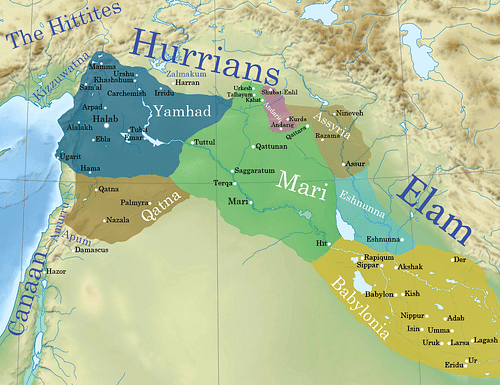
It is thought that Terah, in taking his family from Sumer, retained the tribe's original ethnic identity and brought that cultural heritage with him to Canaan where Abraham, then Isaac, and then Jacob would establish that culture as 'the children of Israel' (Jacob's name). The Book of Genesis tells the story of Joseph, Jacob's youngest son, and his sojourn in Egypt and rise to power there, and the Book of Exodus relates how the Hebrews were later enslaved by the Egyptians and were led from captivity to freedom back in Canaan by Moses. These biblical narratives would have served to separate the Israelites' national identity from their actual ancestors by creating new histories that highlighted their uniqueness among the people of the world. Kriwaczek notes that,
only by leaving Ur would Terah and his little family keep their Amorite identity and their Amorite way of life which was so important to subsequent Hebrew history. Had Terah stayed in Sumer, Abram would have shared in a very different destiny…The Amorites would never leave. They would eventually merge into the general population so thoroughly that after a few decades it would be impossible to distinguish them from their predecessors. (165)
The fact that the events related in the Book of Exodus are not substantiated in any other ancient work, or by archaeological evidence of any kind whatsoever, supports the theory that the Hebrew writers of that book created a new narrative to explain their presence in Canaan, one without any connection to the Amorites of Mesopotamia. Throughout the early books of the Old Testament, the Amorites are repeatedly referred to negatively, except for a passage frequently cited from I Samuel 7:14 where some scholars claim that it is written that there was peace between the Amorites and the Children of Israel. But that passage actually says there was peace between the Philistines and the Israelites and does not mention the Amorites at all.
This interpretation of the passage comes from the understanding that 'Amorite' had again come to refer to any nomadic people who interfered with established communities. While this may be true, it seems that 'Amorite' was even used to reference the early people of the land of Canaan which, according to the Book of Joshua, the Israelites conquered. In virtually every reference, then, the Amorites were considered 'the other' by the Hebrew scribes, and this tradition continued for centuries down to the creation of the Talmud in which Jews are prohibited from engaging in Amorite practices. According to the Jewish Encyclopedia:
To the apocryphal writers of the first and second pre-Christian century [the Amorites] are the main representatives of heathen superstition, loathed as idolaters, in whose ordinances Israelites may not walk (Lev. xviii. 3). A special section of the Talmud (Tosef., Shab. vi.-vii. [vii.-viii.]; Bab. Shab. 67a et seq.) is devoted to the various superstitions called "The Ways of the Amorites." According to the Book of Jubilees (xxix. [9] 11), "the former terrible giants, the Rephaim, gave way to the Amorites, an evil and sinful people whose wickedness surpasses that of any other, and whose life will be cut short on earth." In the Syriac Apocalypse of Baruch (lx.) they are symbolized by "black water" on account of "their black art, their witchcraft and impure mysteries, by which they contaminated Israel in the time of the Judges"
The theory that the Amorites, through their appropriation and transmission of Mesopotamian myths, would produce the biblical narratives of the Old Testament, has been challenged repeatedly over the years and, no doubt, will continue to be. There seems to be more evidence to support this theory, however, than disprove it.
The Amorite Period in Mesopotamia
Following the sack of Ur in 1750 BCE, the Amorites merged with the Sumerian population in southern Mesopotamia. They had already been established in the cities of Mari and Ebla in Syria since 1900 BCE (Mari) and 1800 BCE (Ebla) and had ruled in Babylon since c. 1984 BCE. The Amorite king Sin-Muballit had assumed the throne in Babylon in 1812 BCE and ruled until 1793 BCE when he abdicated. He was succeeded by his son Ammurapi who is better known by his Akkadian name Hammurabi. The fact that an Amorite king ruled in Babylon prior to the fall of Ur supports the claim that not all 'Amorites' were Amorites and that, as previously mentioned, the term was used rather loosely to refer to any nomadic tribe in the Near East.
The Amorites of Babylon seem to have been regarded positively in the region, while the roaming Amorites continued to be a source of instability. The Amorites of Babylon, just as those who inhabited other cities, worshipped Sumerian gods and wrote down Sumerian myths and legends. Hammurabi expanded the old city of Babylon and engaged in a number of successful military campaigns (one being the destruction of rival city Mari in 1761 BCE) that brought the vast region of Mesopotamia from Mari to Ur under Babylon's rule and established the city as the center of Babylonia (an area of land corresponding to modern-day Syria to the Persian Gulf). Hammurabi's military, diplomatic, and, political skills served to make Babylon the largest city in the world at the time and the most powerful. He was unable, however, to pass these talents on to his son and, after his death, the kingdom he had built began to fall apart.
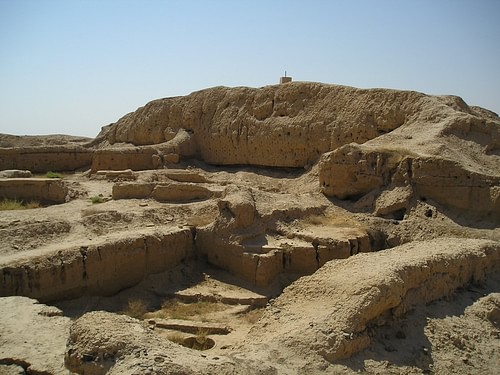
Hammurabi's son, Samsu-Iluna (r. 1749-1712 BCE) could not continue the policies his father had enacted nor defend the empire against invading forces such as the Hittites and Assyrians. The Assyrians were the first to make incursions and allowed for regions south of Babylon to break away from the empire easily. Hammurabi's conquest of Eshnunna in the north-east had removed a buffer zone and placed the border in direct contact with tribes such as the Kassites. The greatest blow came in 1595 BCE when Mursilli I of the Hittites (1620-1590 BCE) sacked Babylon and carried away the treasures of the city's temples and scattered the population, as he had done five years earlier, in 1600 BCE, at Ebla.
The Kassites followed the Hittites in taking Babylon and renaming it, and they, in turn, were followed by the Assyrians. The Amorite Period in Mesopotamia was ended by 1600 BCE, though it is clear through the distinctive Semitic names of individuals on record that Amorites continued to live in the area as part of the general population. Amorites continued to pose problems for the Neo-Assyrian Empire as late as c. 900-800 BCE. Who these 'Amorites' were, and whether they were culturally Amorite, is unclear. In time, the cultural Amorites came to be referred to as 'Aramaeans' and the land they came from as Aram, possibly from the old designation of Eber Nari. Following the decline of the Neo-Assyrian Empire in c. 600 BCE, Amorites no longer appear under the name 'Amorite' in the historical record.
